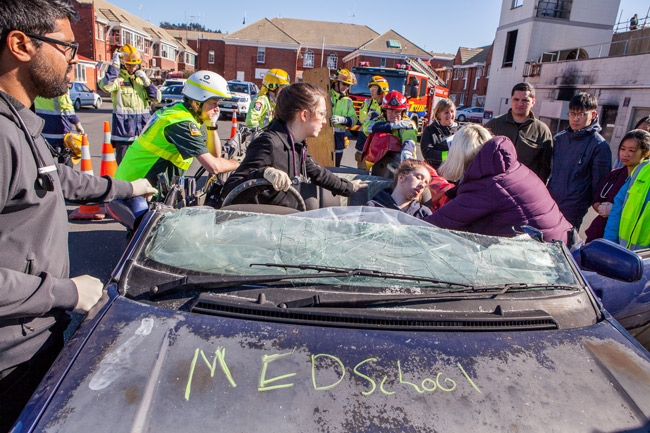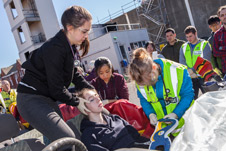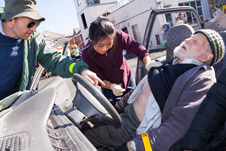
Fifth year medical students in action at a mock accident scene. Photos: Sharron Bennett.
The University of Otago's 5th year medical students going through their Rural General Practice rotation were recently put to the test with a car crash.
The simulation exercise at the Dunedin City Fire Station in August was one of four this year, organised by the Department of General Practice and Rural Health (Dunedin School of Medicine) in conjunction with the St John Ambulance Service and the NZ Fire Service.
This is a regular part of the Rural General Practice rotation, which is part of the Advanced Learning in Medicine (ALM) programme, and has been going for several years.
Eighty 5th year students rotate through the programme in four groups of 20 each year; they have an introductory week and a review/exam week in the Department, and the five middle weeks are spent out on placement, ideally with rural GPs. Placement sites cover the whole of the South Island, from Takaka to Riverton, and Hokitika to Oamaru.
The simulated motor vehicle accident is held during the introduction week for each of the four groups, as part of their preparation for going out on placement.

Professional Practice Fellow Dr Peter Radue, academic staff for General Practice & Rural Health, Dunedin School of Medicine, Health Sciences, said the training was very successful; the students have to 'rise to the occasion', which they unfailingly manage to do.
“It's a stressful, unfamiliar situation with loud noises and distressed, injured, potentially dying 'patients'. The students have to work together as a team, and work with the Ambulance and Fire personnel once the latter services arrive on the scene,” Dr Radue said.
“The students learn about emergency services, working safely at an accident scene, triaging patients - prioritising those with more serious, immediately life-threatening injuries - and stabilising and transporting the injured as necessary.”
For example, the 'patient' with a fractured pelvis needs to be extracted from the vehicle and a compression belt applied to stabilise her pelvis, before she is transferred to hospital for definitive care (an operation). Another, unconscious, 'patient' needs her airway to be opened and her head held up in alignment to keep it open. A patient with a suspected spinal injury – neck or back – might need careful immobilisation to prevent potential spinal cord injury.

"Most importantly, the students realise that they can stay calm and cope, and potentially contribute in a real situation – some of them have attended the motor vehicle accident simulation and, within weeks while out on placement, attended real accidents or other emergencies, sometimes even involving fatalities."
“I think the simulation is great preparation for this, and makes it less likely that they will 'freeze' or feel too inadequate to provide a very useful extra pair of hands to assist the medical/emergency personnel involved.”
St John and the Fire Service contribute to the teaching and participate in the simulation, and the Fire Service crew get to practise cutting patients out of vehicles.
Dr Radue said they use trained actors as 'patients' and they are excellent – several of them have been coming back year after year.